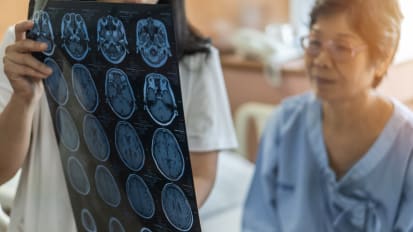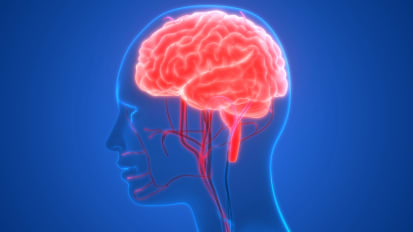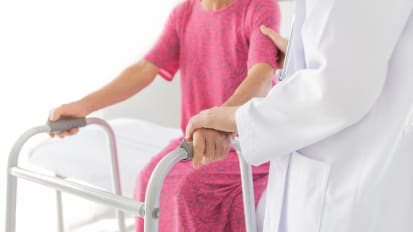University Hospitals 2021 Stroke Update & 16th Annual Neuroscience Nursing Symposium
Release Date: October 29, 2021
Expiration Date: October 28, 2024
PROGRAM AGENDA
Target Audience
This continuing medical education activity is intended for physicians, nurses and other allied health professionals.
Learning Objectives
After attending this program, participants will be able to:
- Recognize the expanding eligibility of stroke patients that may benefit from mechanical thrombectomy.
- Describe cerebrovascular anatomy.
- State imaging preferences for stroke diagnoses.
- Discuss assessment and management of airway and respiratory failure in an acute stroke patient.
- Verbalize weaning and monitoring protocols for ventilated stroke patients.
- Summarize the diagnosis and management of a patient with an arteriovenous malformations (AVM).
- Explain nursing implications for the AVM patient experiencing a sympathetic storm.
- Identify pharmaceutical management for the AVM patient experiencing sympathetic storm.
- Describe the assessment of a post ICU syndrome.
- Define how implementing a mobility program can minimize Post-Intensive Care Syndrome.
- Recognize COVID-19 neurological syndromes.
- Describe post COVID-19 neurological complications and the benefits of a supportive clinic.
- Review the assessment and management of a patient with a spinal cord infarct.
- Explain the therapy interventions for a spinal cord infarct patient.
- State the benefits for patients to recover and heal at home.
- List components of a comprehensive stroke family assessment.
- Describe goals and criteria for acute inpatient rehabilitation.
Media
Zoom recorded presentations with power point slides and speaker videos.
Planning Committee
Cathy Sila MD, FAHA
Dr. Sila, planner for this educational event, has served on the Advisory Committee or Panel for AstraZeneca, Genentech, and Coherex, Inc. All of the relevant financial relationships listed for these individuals have been mitigated.
None of the following planners for this educational activity have relevant financial relationship(s) to disclose with ineligible companies whose primary business is producing, marketing, selling, re-selling, or distributing healthcare products used by or on patients:
Mary Beemiller BSN, RN
Melissa Brately BSN, RN, SCRN
Matthew Eckinger BSN, RN, PCCN
Kim Findura RN
Julie Fussner BSN, RN, CPHQ, SCRN
Kelly Montgomery BSN, RN, SCRN
Danielle Sindelar MSN, RN, CMSRN
Erin Supan MSN, RN, APRN-CNS, CNRN
Chase Vlad BSN, RN, CCRN
Accreditation Statement
Case Western Reserve University School of Medicine is accredited by the Accreditation Council for Continuing Medical Education to provide continuing medical education for physicians.
Case Western Reserve University School of Medicine designates this live activity for a maximum of 7.25 AMA PRA Category 1 CreditsTM. Physicians should claim only the credit commensurate with the extent of their participation in the activity.
Disclosure Statement
The policy of Case Western Reserve University School of Medicine CME Program requires that the Activity Director, planning committee members and all activity faculty (that is, anyone in a position to control the content of the education activity) disclose to the activity participants all relevant financial relationships with commercial interests. Disclosure will be made to activity participants prior to the commencement of the activity. Case Western Reserve University School of Medicine also requires that faculty make clinical recommendations based on the best available scientific evidence and that faculty identify any discussion of “off-label” or investigational use of pharmaceutical products or medical devices.
Instructions
To receive a statement of credit from .75 to maximum 7.25 AMA PRA Category 1 CreditTMyou must:
- Review and reflect on the full content of the recorded session.
- Complete the evaluation.
Your credits will be recorded by the CWRU CME Program and made a part of your cumulative transcript.
Estimated Time to Complete this Educational Activity
Including review of any resource material and completion of the post-test, this activity is expected to take 7.25 hours to complete all modules.
Fee
There is no fee for this program.
To contact the CME Provider: Email CWRU CME at medcme@case.edu
Resources
- Guidelines for the Early Management of Patients With Acute Ischemic Stroke: 2019 Update to the 2018 Guidelines for the Early Management of Acute Ischemic Stroke A Guideline for Healthcare Professionals From the American Heart Association/American Stroke Association Endorsed by the Society for Academic Emergency Medicine and The Neurocritical Care Society William J. Powers, MD, FAHA, Chair; and et al; on behalf of the American Heart Association Stroke Council Stroke. 2019;50:e???–e???. doi: 10.1161/STR.0000000000000211
- Optimizing Patient Selection for Endovascular Treatment in Acute Ischemic Stroke (SELECT): A Prospective, Multicenter Cohort Study of Imaging Selection Sarraj et al. (2020) Ann Neurol. First published: 09 January 2020 https://doi.org/10.1002/ana.25669
- Thrombectomy 6 to 24 Hours after Stroke with a Mismatch between Deficit and Infarct R.G Nogueira, MD and et al:
Orignially published 17 Nov 2017. DOI: 10.1056/NEJMoal 706442 - Rajajee V, Riggs B, Seder DB. Emergency Neurological Life Support: Airway, Ventilation, and Sedation. Neurocrit Care. 2017;27:4-28.
- Conventional Weaning Parameters do not Predict Extubation Failure in Neurocritical Care Patients - Neuro Critical Care Journal, January 2009
- Management of Brain Arteriovenous Malformations: A Scientific Statement for Healthcare Professionals From the American Heart Association/American Stroke Association Colin P. Derdeyn et al. and on behalf of the American Heart Association Stroke Council https://doi.org/10.1161/STR.0000000000000134Stroke. 2017;48:e200–e22
- Meyfroidt G, Baguley IJ, Menon DK. Paroxysmal sympathetic hyperactivity: the storm after acute brain injury. Lancet Neurol. 2017 Sep;16(9):721-729. doi: 10.1016/S1474-4422(17)30259-4. Erratum in: Lancet Neurol. 2018 Mar;17 (3):203. PMID: 28816118.
- Lexicomp Online, Lexi-drugs Online, Hudson, Ohio: Wolters Kluwer Clinical Drug Information, Inc.; 2013
- Balas MC, et al. Effectiveness and safety of the awakening and breathing coordination, delirium monitoring/management, and early exercise/mobility (ABCDE) bundle. Critical Care Med 2014, 42 (5): 1024-36.
- Schwelckert WD, et al. Early mobilization improved functional outcomes in critically ill patients. Critical Care 2009, 373 (9678): 1875-82.
- Putting a Dent in the Trillion Dollar Problem.Pronovost et. al. NEJM Catalyst 2020
- University Hospitals Policy and Procedure: CP-24 – Care Transitions, Discharge Planning,Revised: December 2019
- Use of an integrated care pathway: A third round audit of the management of shoulder pain in neurological conditions. Jackson, Diana & Turner-Stokes, Lynne & Williams, Heather & Das-Gupta, Rana. (2003). Journal of rehabilitation medicine: official journal of the UEMS European Board of Physical and Rehabilitation Medicine. 35. 265-70. 10.1080/16501970310012446.
- Neurogenic Bowel Treatment. Krassioukov, et al, Spinal Cord, 2010, 48:718-733
- Occupational Therapy and the Care of Individuals With Spinal Cord Injury American Occupational Therapy Association. (2014). Occupational therapy practice framework: Domain and process (3rd ed.). American Journal of Occupational Therapy, 68(Suppl.1), S1–S48. http://dx.doi.org/10.5014/ajot.2014.682006
- Multi-Disciplinary Collaborative Consensus Guidance Statement on the Assessment and Treatment of Fatigue in Post-Acute Sequelae of SARS-CoV-2 infection (PASC) Patients. Herrera, J. E., et al. (2021). PM & R: the journal of injury, function, and rehabilitation.
- Ischemic Stroke, Inflammation, and Endotheliopathy in COVID-19 Patients McAlpine et al. Stroke. 2021;52:e233-e238


























